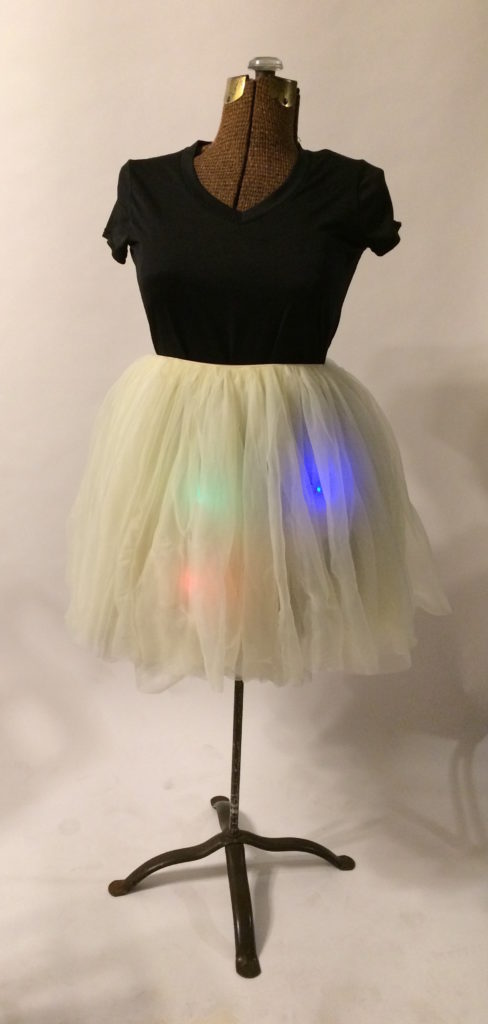This summer I made something that I am really proud of! I illuminated a tutu with a LilyPad Arduino using only online resources. I was challenged to set aside traditional learning resources, which I wrote about in an earlier post.
My Struggles
In a previous post on this topic, I wrote about my lack of experience with this platform. I also wrote about switching between Uno and LilyPad.
After I got my Uno controlling a series of LEDs on a breadboard, my next step was to code the Uno to control four NeoPixel LEDs. I installed the NeoPixel library in the Arduino IDE.
I coded a simple sketch to illuminate the NeoPixels. Then I pulled in an example sketch from the NeoPixel library. The steps in coding are: write the sketch, verify it, then upload it. In my experience coding, if error messages come back at either the verify or upload stage, the sketch will not work.
I got a message when I attempted to upload my sketch that said, “User configuration file does not exist or is not a regular file, skipping.” In RED. That was one of approximately 60 lines in the error message.
So I researched. For hours, I read Internet help forums in which other Arduino Makers had reported the same error. From what I could find, it appeared that my version of Mac OS was not going to work with Arduino. I began to envision having to scrap this project and start over. I spent at least four hours reading and uninstalling and reinstalling the Arduino IDE. I even opened the Mac Terminal and considered manually inputting some instructions directly into the command line.
Then it happened. After hours of reading and more than a few tears shed, I found it. On the Arduino Product Forum, someone had written, “Don’t worry, it’s not an issue to have this message – it will use the supplied default. :)” The smiley face was really included in the forum post. I am sure I had read this message ten times. This time, though, I realized what it meant: my code would work, in spite of the error message. I tried one more time and it worked!
 My troubles weren’t over, however. When I tried to switch from the Uno to the LilyPad, I discovered that my LilyPad had gotten broken so I ordered a new one. Once it arrived, I was finally able to switch from the Uno to the LilyPad and got my LilyPad to light up the NeoPixels.
My troubles weren’t over, however. When I tried to switch from the Uno to the LilyPad, I discovered that my LilyPad had gotten broken so I ordered a new one. Once it arrived, I was finally able to switch from the Uno to the LilyPad and got my LilyPad to light up the NeoPixels.
My Success
Next, I connected all the NeoPixels to the LilyPad using wire and electrical tape. It would have been more elegant to use conductive thread but I made this choice in the interest of time.
Finally, I moved the LilyPad to battery power. I attached my daisy-chained NeoPixels and the LilyPad to the tutu. The results were lovely, and I was delighted.
As Jaymes Dec, teacher and Innovation Specialist says of digital tools, including Arduino, “I really want my students to lose their fear of failure,” (Burker, 2015, Loc 1731). I can attest to the fact that I truly thought I was about to fail during this project. In the end, I succeeded. I made something I didn’t know I could make and I learned a lot about microprocessors and myself in the process. Through persistence, I can figure out just about anything. And when something is so difficult that it hurts, overcoming is the sweetest success!
please watch my maker video about how I completed this project:
Resources That I Used For Learning Arduino
- Tutorial 01 for Arduino: Getting Acquainted with Arduino
- Arduino Programming Videos // Maker 101
- How To Use a Breadboard
- Installing Additional Arduino Libraries
- Arduino Product Forum
- LilyPad Pixel Board Hookup Guide
- Sewable NeoPixels
- NeoPixel Library
If you’re interested in getting started with Arduino, you may also enjoy the extended edit of my maker video:
Related Posts
This is the third of three posts about learning to code the Arduino. You can read about my decision to make this project in my first post. You can read an update about my early progress in my second post.
References
Burker, J. (2015). The invent to learn: Guide to fun. Torrance, CA: Constructing Modern Knowledge Press. Retrieved from https://www.amazon.com/Invent-Learn-Tinkering-Engineering-Classroom-ebook/dp/B00CQDRF84/ref=sr_1_1_twi_kin_1?ie=UTF8&qid=1501470374&sr=8-1&keywords=kindle+invent+to+learn
Images
All images and videos in this blog post were created by Sarah Van Loo.
